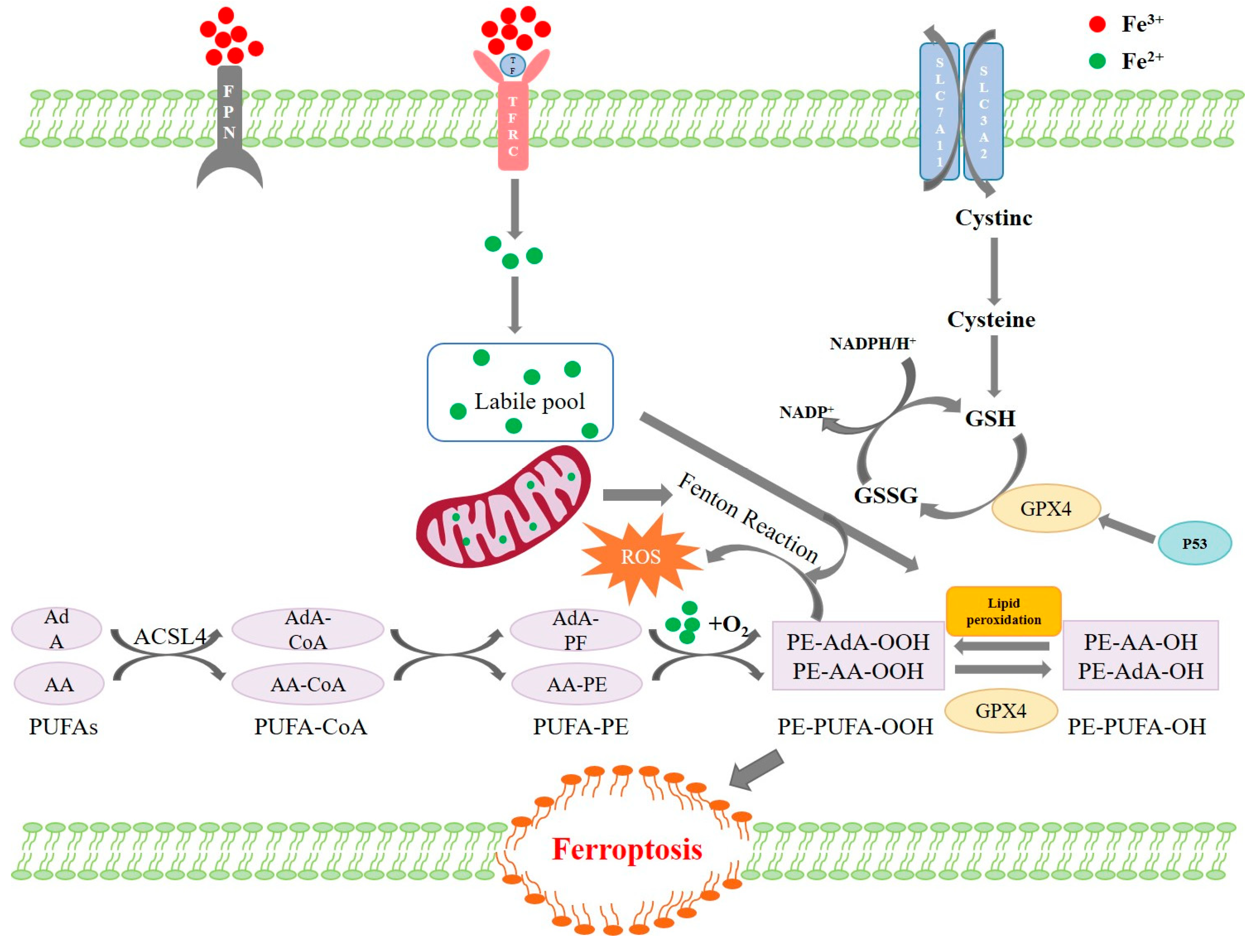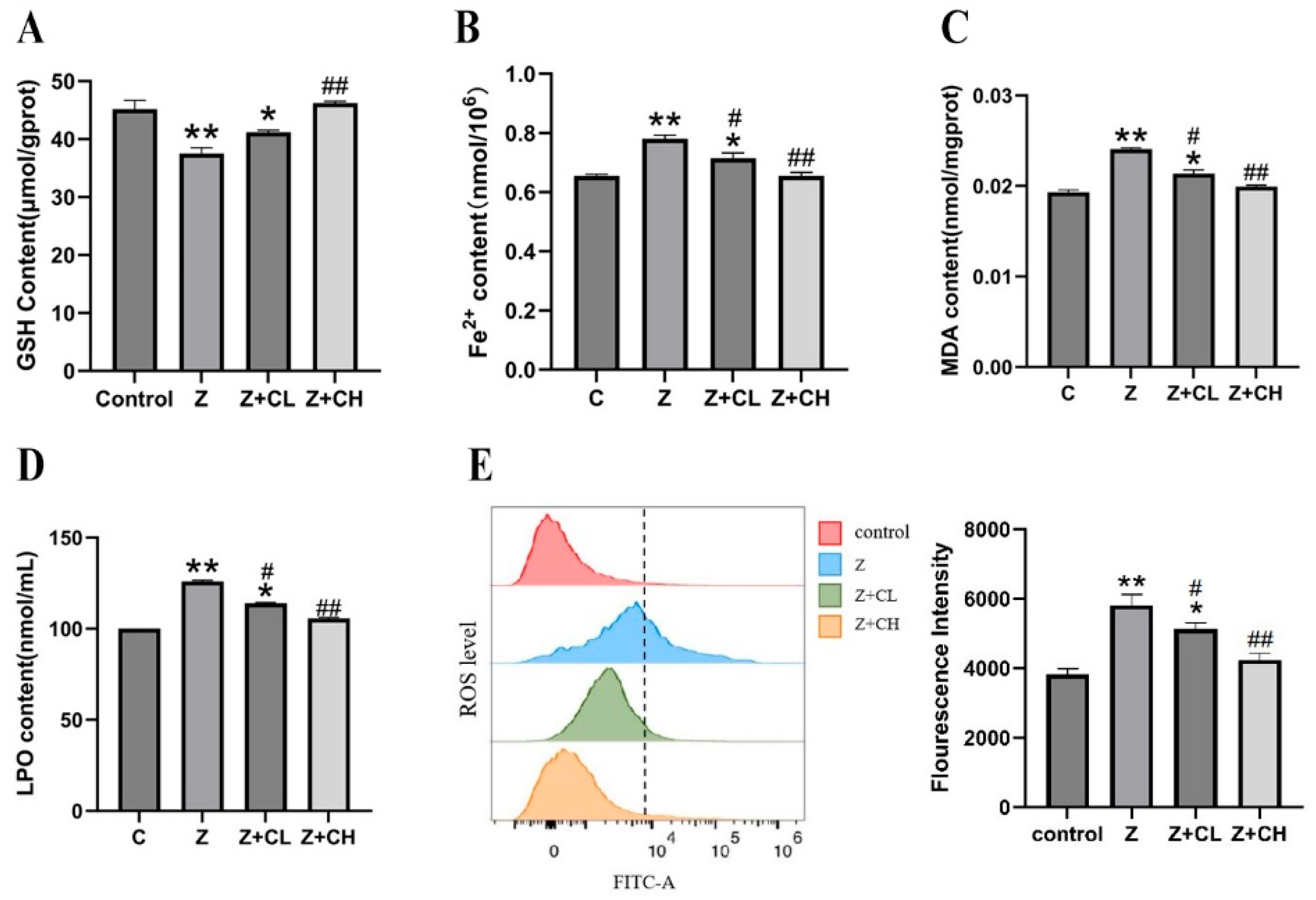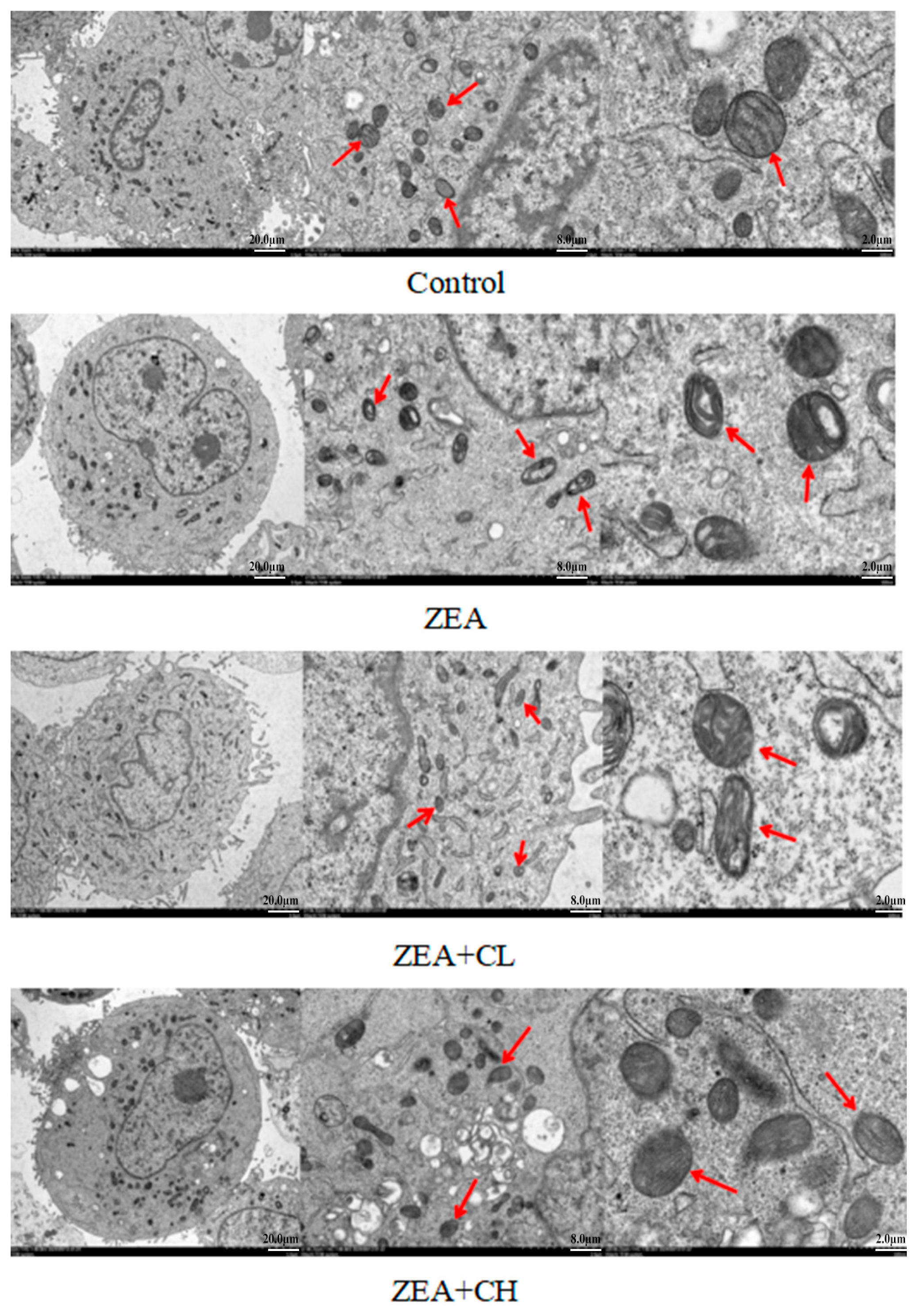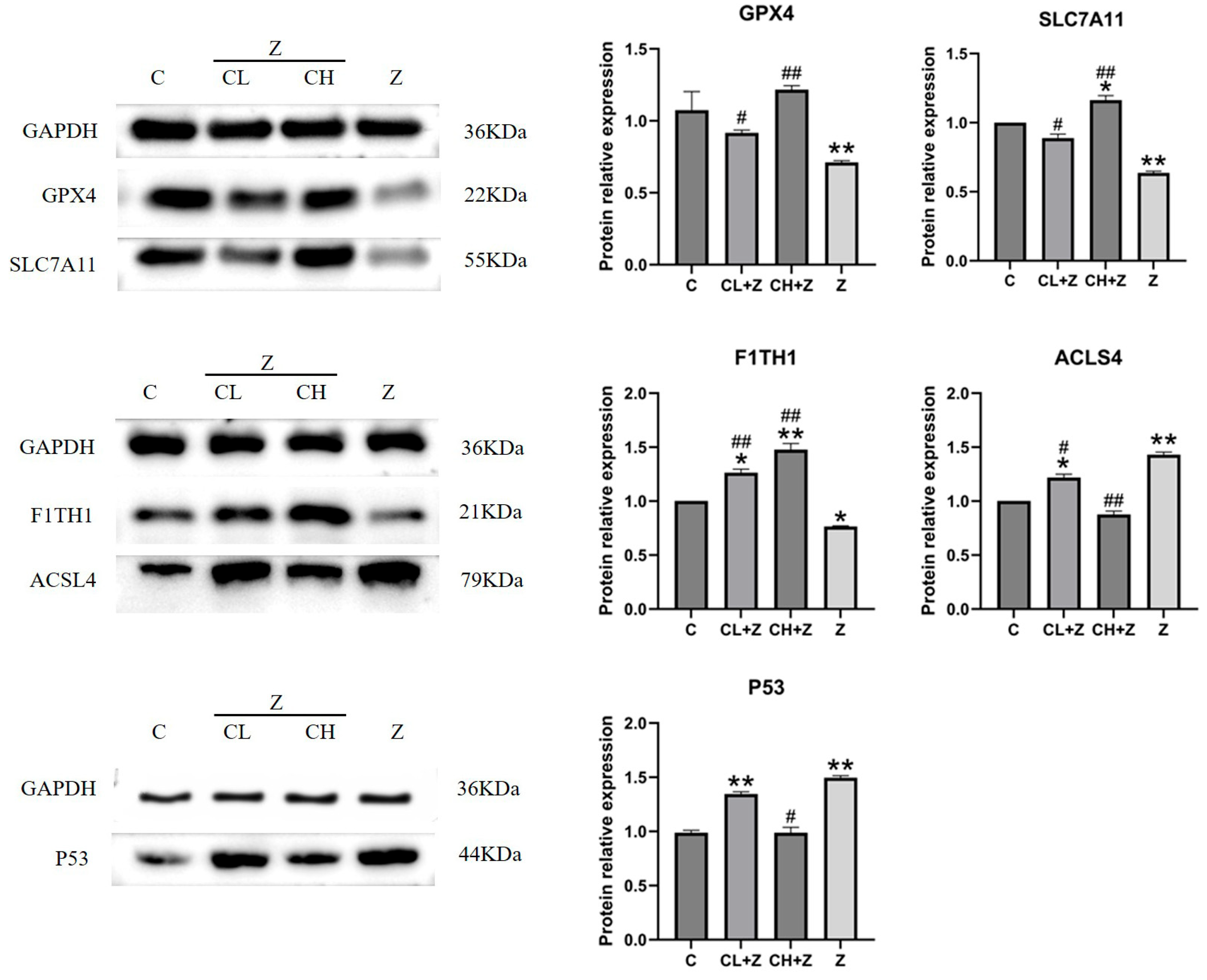Curcumin Can Inhibit Zearalenone-Induced Ferroptosis in Porcine Intestinal Epithelial Cells via the p53/SLC7A11/GPX4 Pathway
Highlights
- Curcumin suppressed ZEA-induced ferroptosis in IPEC-J2 cells by restoring redox balance, reducing iron overload, and protecting mitochondria.
- Curcumin reversed ZEA-induced downregulation of SLC7A11 and GPX4 and suppressed p53 activation.
- These findings reveal a novel mechanistic insight into ferroptosis as a key pathway in ZEA-induced intestinal toxicity.
- Curcumin shows potential as a feed additive to mitigate mycotoxin damage, improving gut health and livestock safety.
Abstract
1. Introduction
2. Materials and Methods
2.1. Culture of IPEC-J2 Cells
2.2. Cytotoxicity Assay and Relative Cell Viability Measurement
- (1)
- Curcumin Treatment and Relative Cell Viability Assay (CCK-8 assay)
- (2)
- Zearalenone Treatment and Relative Cell Viability Assay (CCK-8 assay)
- (3)
- Investigation of the Combined Effects of CUR and ZEA (CCK-8 assay)
2.3. Measurement of GSH, Fe2+, LPO, and MDA Contents
- (1)
- Measurement of GSH Contents
- (2)
- Measurement of Fe2+ Contents
- (3)
- Measurement of Lipid peroxidation (LPO) Contents
- (4)
- Measurement of Malondialdehyde (MDA) Contents
2.4. Flow Cytometric Analysis of ROS Production in IPEC-J2 Cells
2.5. Observation of Mitochondrial Damage in IPEC-J2 Cells by Transmission Electron Microscopy
2.6. Validation of Target Gene Expression
2.7. Western Blotting to Assess the Expression of Ferroptosis-Associated Proteins
3. Results
3.1. The Cytotoxic Effects of ZEA and CUR on IPEC-J2 Cells
3.2. The Impact of ZEA and CUR on Oxidative Stress and Iron Homeostasis in IPEC-J2 Cells
3.3. The Impact of ZEA and CUR on Mitochondrial Injury in IPEC-J2 Cells
3.4. mRNA Expression Levels of Ferroptosis-Related Genes in IPEC-J2 Cells
3.5. Expression Levels of Ferroptosis-Related Proteins in IPEC-J2 Cells
4. Discussion
5. Conclusions
Author Contributions
Funding
Institutional Review Board Statement
Informed Consent Statement
Data Availability Statement
Conflicts of Interest
References
- Rai, A.; Das, M.; Tripathi, A. Occurrence and toxicity of a fusarium mycotoxin, zearalenone. Crit. Rev. Food Sci. Nutr. 2020, 60, 2710–2729. [Google Scholar] [CrossRef]
- Yang, C.; Song, G.; Lim, W. Effects of mycotoxin-contaminated feed on farm animals. J. Hazard. Mater. 2020, 389, 122087. [Google Scholar] [CrossRef] [PubMed]
- Jing, S.; Liu, C.; Zheng, J.; Dong, Z.; Guo, N. Toxicity of zearalenone and its nutritional intervention by natural products. Food Funct. 2022, 13, 10374–10400. [Google Scholar] [CrossRef] [PubMed]
- Kowalska, K.; Habrowska-Gorczynska, D.E.; Urbanek, K.A.; Dominska, K.; Sakowicz, A.; Piastowska-Ciesielska, A.W. Estrogen receptor beta plays a protective role in zearalenone-induced oxidative stress in normal prostate epithelial cells. Ecotoxicol. Environ. Saf. 2019, 172, 504–513. [Google Scholar] [CrossRef] [PubMed]
- Wang, S.; Fu, W.; Zhao, X.; Chang, X.; Liu, H.; Zhou, L.; Li, J.; Cheng, R.; Wu, X.; Li, X.; et al. Zearalenone disturbs the reproductive-immune axis in pigs: The role of gut microbial metabolites. Microbiome 2022, 10, 234. [Google Scholar] [CrossRef]
- Wu, K.; Ren, C.; Gong, Y.; Gao, X.; Rajput, S.A.; Qi, D.; Wang, S. The insensitive mechanism of poultry to zearalenone: A review. Anim. Nutr. 2021, 7, 587–594. [Google Scholar] [CrossRef]
- Kim, N.Y.; Kim, M.O.; Shin, S.; Kwon, W.S.; Kim, B.; Lee, J.Y.; In, L.S. Effect of atractylenolide III on zearalenone-induced Snail1-mediated epithelial-mesenchymal transition in porcine intestinal epithelium. J. Anim. Sci. Biotechnol. 2024, 15, 80. [Google Scholar] [CrossRef]
- Lin, X.; Zhu, L.; Gao, X.; Kong, L.; Huang, Y.; Zhao, H.; Chen, Y.; Wen, L.; Li, R.; Wu, J.; et al. Ameliorative effect of betulinic acid against zearalenone exposure triggers testicular dysfunction and oxidative stress in mice via p38/ERK MAPK inhibition and Nrf2-mediated antioxidant defense activation. Ecotoxicol. Environ. Saf. 2022, 238, 113561. [Google Scholar] [CrossRef]
- Cao, L.; Fan, L.; Zhao, C.; Yin, S.; Hu, H. Role of ferroptosis in food-borne mycotoxin-induced toxicities. Apoptosis 2024, 29, 267–276. [Google Scholar] [CrossRef]
- Huangfu, B.; Li, J.; Xu, T.; Ren, X.; Zhang, R.; Chen, Y.; Wang, J.; Huang, K.; He, X. Zearalenone induces intestinal damage and flora disturbance in rats by triggering ferroptosis via the system Xc(-)-GSH-GPX4 signaling pathway. Ecotoxicol. Environ. Saf. 2025, 302, 118600. [Google Scholar] [CrossRef]
- Wang, C.; Chen, C.; Wang, M.; Rahman, S.U.; Wei, B.; Ding, H.; Huang, W.; Wang, X. Rutin attenuates zearalenone-induced ferroptosis of endometrial stromal cells in piglets through the p53 signaling pathway. Ecotoxicol. Environ. Saf. 2025, 290, 117546. [Google Scholar] [CrossRef] [PubMed]
- Zhang, H.J.; Luo, J.Z.; Lan, C.L.; Teng, X.; Ge, B.; Liu, J.Q.; Xie, H.X.; Yang, K.J.; Qin, C.J.; Zhou, X.; et al. Baicalin protects against hepatocyte injury caused by aflatoxin B(1) via the TP53-related ferroptosis Pathway. Ecotoxicol. Environ. Saf. 2024, 281, 116661. [Google Scholar] [CrossRef] [PubMed]
- Wang, W.; Ma, F.; Cheung, Y.T.; Zeng, G.; Zhou, Y.; Chen, Z.; Liang, L.; Luo, T.; Tong, R. Marine alkaloid lepadins e and h induce ferroptosis for cancer chemotherapy. J. Med. Chem. 2023, 66, 11201–11215. [Google Scholar] [CrossRef] [PubMed]
- Zhi, S.M.; Cui, Y.; Liu, Y.; Zhang, J.T.; Li, X.J.; Sheng, B.; Chen, X.X.; Yan, C.L.; Li, W.; Mao, J.N.; et al. Paeoniflorin suppresses ferroptosis after traumatic brain injury by antagonizing P53 acetylation. Phytomedicine 2024, 133, 155940. [Google Scholar] [CrossRef]
- Sun, D.; Wang, L.; Wu, Y.; Yu, Y.; Yao, Y.; Yang, H.; Hao, C. Lipid metabolism in ferroptosis: Mechanistic insights and therapeutic potential. Front. Immunol. 2025, 16, 1545339. [Google Scholar] [CrossRef]
- Wang, X.; Kong, X.; Feng, X.; Jiang, D.S. Effects of DNA, RNA, and protein methylation on the regulation of ferroptosis. Int. J. Biol. Sci. 2023, 19, 3558–3575. [Google Scholar] [CrossRef]
- Kaur, K.; Al-Khazaleh, A.K.; Bhuyan, D.J.; Li, F.; Li, C.G. A review of recent curcumin analogues and their antioxidant, Anti-Inflammatory, and anticancer activities. Antioxidants 2024, 13, 1092. [Google Scholar] [CrossRef]
- Li, R.; Zhang, J.; Zhou, Y.; Gao, Q.; Wang, R.; Fu, Y.; Zheng, L.; Yu, H. Transcriptome investigation and in vitro verification of curcumin-induced HO-1 as a feature of ferroptosis in breast cancer cells. Oxid. Med. Cell. Longev. 2020, 2020, 3469840. [Google Scholar] [CrossRef]
- Zhang, Y.; Yu, C.; Peng, C.; Peng, F. Potential roles and mechanisms of curcumin and its derivatives in the regulation of ferroptosis. Int. J. Biol. Sci. 2024, 20, 4838–4852. [Google Scholar] [CrossRef]
- Ming, T.; Lei, J.; Peng, Y.; Wang, M.; Liang, Y.; Tang, S.; Tao, Q.; Wang, M.; Tang, X.; He, Z.; et al. Curcumin suppresses colorectal cancer by induction of ferroptosis via regulation of p53 and solute carrier family 7 member 11/glutathione/glutathione peroxidase 4 signaling axis. Phytother. Res. 2024, 38, 3954–3972. [Google Scholar] [CrossRef]
- Cheng, Q.; Jiang, S.; Huang, L.; Wang, Y.; Yang, W. Zearalenone exposure affects the Keap1-Nrf2 signaling pathway and glucose nutrient absorption related genes of porcine jejunal epithelial cells. Toxins 2022, 14, 793. [Google Scholar] [CrossRef]
- Wang, C.; Fu, Y.; Wang, R.; Wang, Q.; Yu, H.; Zhang, J. Quercetin attenuates the combined effects of zearalenone and lipopolysaccharide on IPEC-J2 cell injury through activating the Nrf2 signaling pathway. Toxins 2023, 15, 679. [Google Scholar] [CrossRef]
- Wang, Q.; Li, A.; Yu, H.; Wang, C.; Wang, T.; Zhang, J. Evaluation of Cross-Talk and alleviate potential of cytotoxic factors induced by deoxynivalenol in IPEC-J2 cells interference with curcumin. Int. J. Mol. Sci. 2024, 25, 6984. [Google Scholar] [CrossRef]
- Sun, H.; Zhang, M.; Li, J.; Shan, A. DL-Selenomethionine alleviates oxidative stress induced by zearalenone via Nrf2/Keap1 signaling pathway in IPEC-J2 cells. Toxins 2021, 13, 557. [Google Scholar] [CrossRef] [PubMed]
- Guan, H.; Ma, W.; Wu, Q.; Cai, J.; Zhang, Z. Exploring the toxic effects of ZEA on IPEC-J2 cells from the inflammatory response and apoptosis. Animals 2023, 13, 2731. [Google Scholar] [CrossRef] [PubMed]
- Bao, L.; Huang, Y.; Gu, F.; Liu, W.; Guo, Y.; Chen, H.; Wang, K.; Wu, Z.; Li, J. Zearalenone induces liver injury in mice through ferroptosis pathway. Sci. Total Environ. 2024, 952, 175875. [Google Scholar] [CrossRef] [PubMed]
- Liu, M.; Zheng, M.; Cai, D.; Xie, J.; Jin, Z.; Liu, H.; Liu, J. Zeaxanthin promotes mitochondrial biogenesis and adipocyte browning via AMPKalpha1 activation. Food Funct. 2019, 10, 2221–2233. [Google Scholar] [CrossRef]
- Rai, A.; Patwardhan, R.S.; Jayakumar, S.; Pachpatil, P.; Das, D.; Panigrahi, G.C.; Gota, V.; Patwardhan, S.; Sandur, S.K. Clobetasol propionate, a Nrf-2 inhibitor, sensitizes human lung cancer cells to radiation-induced killing via mitochondrial ROS-dependent ferroptosis. Acta Pharmacol. Sin. 2024, 45, 1506–1519. [Google Scholar] [CrossRef]
- Mortensen, M.S.; Ruiz, J.; Watts, J.L. Polyunsaturated fatty acids drive lipid peroxidation during ferroptosis. Cells 2023, 12, 804. [Google Scholar] [CrossRef]
- Ding, K.; Liu, C.; Li, L.; Yang, M.; Jiang, N.; Luo, S.; Sun, L. Acyl-CoA synthase ACSL4: An essential target in ferroptosis and fatty acid metabolism. Chin. Med. J. 2023, 136, 2521–2537. [Google Scholar] [CrossRef]
- Doll, S.; Proneth, B.; Tyurina, Y.Y.; Panzilius, E.; Kobayashi, S.; Ingold, I.; Irmler, M.; Beckers, J.; Aichler, M.; Walch, A.; et al. ACSL4 dictates ferroptosis sensitivity by shaping cellular lipid composition. Nat. Chem. Biol. 2017, 13, 91–98. [Google Scholar] [CrossRef]
- Ohshima, T.; Yamamoto, H.; Sakamaki, Y.; Saito, C.; Mizushima, N. NCOA4 drives ferritin phase separation to facilitate macroferritinophagy and microferritinophagy. J. Cell Biol. 2022, 221, e202203102. [Google Scholar] [CrossRef] [PubMed]
- Yu, F.; Zhang, Q.; Liu, H.; Liu, J.; Yang, S.; Luo, X.; Liu, W.; Zheng, H.; Liu, Q.; Cui, Y.; et al. Dynamic O-GlcNAcylation coordinates ferritinophagy and mitophagy to activate ferroptosis. Cell Discov. 2022, 8, 40. [Google Scholar] [CrossRef] [PubMed]
- Cui, J.; Chen, Y.; Yang, Q.; Zhao, P.; Yang, M.; Wang, X.; Mang, G.; Yan, X.; Wang, D.; Tong, Z.; et al. Protosappanin a protects DOX-Induced myocardial injury and cardiac dysfunction by targeting ACSL4/FTH1 Axis-Dependent ferroptosis. Adv. Sci. 2024, 11, e2310227. [Google Scholar] [CrossRef] [PubMed]
- Hu, W.; Zhou, C.; Jing, Q.; Li, Y.; Yang, J.; Yang, C.; Wang, L.; Hu, J.; Li, H.; Wang, H.; et al. FTH promotes the proliferation and renders the HCC cells specifically resist to ferroptosis by maintaining iron homeostasis. Cancer Cell Int. 2021, 21, 709. [Google Scholar] [CrossRef]
- Pekec, T.; Lewandowski, J.; Komur, A.A.; Sobanska, D.; Guo, Y.; Switonska-Kurkowska, K.; Malecki, J.M.; Dubey, A.A.; Pokrzywa, W.; Frankowski, M.; et al. Ferritin-mediated iron detoxification promotes hypothermia survival in Caenorhabditis elegans and murine neurons. Nat. Commun. 2022, 13, 4883. [Google Scholar] [CrossRef]
- Liu, D.S.; Duong, C.P.; Haupt, S.; Montgomery, K.G.; House, C.M.; Azar, W.J.; Pearson, H.B.; Fisher, O.M.; Read, M.; Guerra, G.R.; et al. Inhibiting the system x(C) (-)/glutathione axis selectively targets cancers with mutant-p53 accumulation. Nat. Commun. 2017, 8, 14844. [Google Scholar] [CrossRef]
- Su, Z.; Kon, N.; Yi, J.; Zhao, H.; Zhang, W.; Tang, Q.; Li, H.; Kobayashi, H.; Li, Z.; Duan, S.; et al. Specific regulation of BACH1 by the hotspot mutant p53(R175H) reveals a distinct gain-of-function mechanism. Nat. Cancer 2023, 4, 564–581. [Google Scholar] [CrossRef]
- Wang, C.; He, J.; Jin, H.; Xiao, H.; Peng, S.; Xie, J.; Zhang, L.; Guo, J. T-2 toxin induces cardiotoxicity by activating ferroptosis and inhibiting heme oxygenase-1. Chemosphere 2023, 341, 140087. [Google Scholar] [CrossRef]
- Wang, G.; Qin, S.; Zheng, Y.; Xia, C.; Zhang, P.; Zhang, L.; Yao, J.; Yi, Y.; Deng, L. T-2 toxin induces ferroptosis by increasing lipid reactive oxygen species (ROS) and downregulating solute carrier family 7 member 11 (SLC7A11). J. Agric. Food Chem. 2021, 69, 15716–15727. [Google Scholar] [CrossRef]
- Lee, J.; Roh, J.L. SLC7A11 as a gateway of metabolic perturbation and ferroptosis vulnerability in cancer. Antioxidants 2022, 11, 2444. [Google Scholar] [CrossRef]
- Upadhyayula, P.S.; Higgins, D.M.; Mela, A.; Banu, M.; Dovas, A.; Zandkarimi, F.; Patel, P.; Mahajan, A.; Humala, N.; Nguyen, T.; et al. Dietary restriction of cysteine and methionine sensitizes gliomas to ferroptosis and induces alterations in energetic metabolism. Nat. Commun. 2023, 14, 1187. [Google Scholar] [CrossRef] [PubMed]
- Xue, X.; Wang, M.; Cui, J.; Yang, M.; Ma, L.; Kang, R.; Tang, D.; Wang, J. Glutathione metabolism in ferroptosis and cancer therapy. Cancer Lett. 2025, 621, 217697. [Google Scholar] [CrossRef] [PubMed]
- Song, X.; Wang, X.; Chen, X.; Yu, Z.; Zhou, Y. SRSF1 inhibits ferroptosis and reduces cisplatin chemosensitivity of triple-negative breast cancer cells through the circSEPT9/GCH1 axis. J. Proteom. 2024, 292, 105055. [Google Scholar] [CrossRef] [PubMed]
- Xu, L.; Zhang, L.; Xiang, Y.; Zhang, X. Knockdown of lncRNA NEAT1 suppresses streptococcus pneumoniae-induced ferroptosis in alveolar epithelial cells by regulating the Nrf2-GPX4 pathway. Toxicon 2024, 243, 107705. [Google Scholar] [CrossRef]
- Tao, L.; Xu, J.; Jiang, L.; Hu, J.; Tang, Z. Investigation into the influence of mild hypothermia on regulating ferroptosis through the P53-SLC7A11/GPX4 signaling pathway in sepsis-induced acute lung injury. Intensive Care Med. Exp. 2025, 13, 4. [Google Scholar] [CrossRef]
- Jin, X.; He, R.; Lin, Y.; Liu, J.; Wang, Y.; Li, Z.; Liao, Y.; Yang, S. Shenshuaifu granule attenuates acute kidney injury by inhibiting ferroptosis mediated by p53/SLC7A11/GPX4 pathway. Drug Des. Dev. Ther. 2023, 17, 3363–3383. [Google Scholar] [CrossRef]
- Li, H.; Sureda, A.; Devkota, H.P.; Pittala, V.; Barreca, D.; Silva, A.S.; Tewari, D.; Xu, S.; Nabavi, S.M. Curcumin, the golden spice in treating cardiovascular diseases. Biotechnol. Adv. 2020, 38, 107343. [Google Scholar] [CrossRef]
- Pei, J.; Palanisamy, C.P.; Natarajan, P.M.; Umapathy, V.R.; Roy, J.R.; Srinivasan, G.P.; Panagal, M.; Jayaraman, S. Curcumin-loaded polymeric nanomaterials as a novel therapeutic strategy for Alzheimer’s disease: A comprehensive review. Ageing Res. Rev. 2024, 99, 102393. [Google Scholar] [CrossRef]
- Scuto, M.; Ontario, M.L.; Salinaro, A.T.; Caligiuri, I.; Rampulla, F.; Zimbone, V.; Modafferi, S.; Rizzolio, F.; Canzonieri, V.; Calabrese, E.J.; et al. Redox modulation by plant polyphenols targeting vitagenes for chemoprevention and therapy: Relevance to novel anti-cancer interventions and mini-brain organoid technology. Free Radic. Biol. Med. 2022, 179, 59–75. [Google Scholar] [CrossRef]
- Wang, Z.; Liu, F.; Liao, W.; Yu, L.; Hu, Z.; Li, M.; Xia, H. Curcumin suppresses glioblastoma cell proliferation by p-AKT/mTOR pathway and increases the PTEN expression. Arch. Biochem. Biophys. 2020, 689, 108412. [Google Scholar] [CrossRef] [PubMed]
- Rainey, N.E.; Moustapha, A.; Petit, P.X. Curcumin, a multifaceted hormetic agent, mediates an intricate crosstalk between mitochondrial turnover, autophagy, and apoptosis. Oxid. Med. Cell. Longev. 2020, 2020, 3656419. [Google Scholar] [CrossRef] [PubMed]
- Wang, L.; Chen, X.; Du, Z.; Li, G.; Chen, M.; Chen, X.; Liang, G.; Chen, T. Curcumin suppresses gastric tumor cell growth via ROS-mediated DNA polymerase gamma depletion disrupting cellular bioenergetics. J. Exp. Clin. Cancer Res. 2017, 36, 47. [Google Scholar] [CrossRef] [PubMed]
- Davoudi, M.; Jadidi, Y.; Moayedi, K.; Farrokhi, V.; Afrisham, R. Ameliorative impacts of polymeric and metallic nanoparticles on cisplatin-induced nephrotoxicity: A 2011–2022 review. J. Nanobiotechnol. 2022, 20, 504. [Google Scholar] [CrossRef]
- Bai, C.; Zhao, J.; Su, J.; Chen, J.; Cui, X.; Sun, M.; Zhang, X. Curcumin induces mitochondrial apoptosis in human hepatoma cells through BCLAF1-mediated modulation of PI3K/AKT/GSK-3beta signaling. Life Sci. 2022, 306, 120804. [Google Scholar] [CrossRef]
- Li, J.; Song, J.; Deng, Z.; Yang, J.; Wang, X.; Gao, B.; Zhu, Y.; Yang, M.; Long, D.; Luo, X.; et al. Robust reactive oxygen species modulator hitchhiking yeast microcapsules for colitis alleviation by trilogically intestinal microenvironment renovation. Bioact. Mater. 2024, 36, 203–220. [Google Scholar] [CrossRef]
- Anand, P.; Kunnumakkara, A.B.; Newman, R.A.; Aggarwal, B.B. Bioavailability of curcumin: Problems and promises. Mol. Pharm. 2007, 4, 807–818. [Google Scholar] [CrossRef]
- Pan-On, S.; Dilokthornsakul, P.; Tiyaboonchai, W. Trends in advanced oral drug delivery system for curcumin: A systematic review. J. Control. Release 2022, 348, 335–345. [Google Scholar] [CrossRef]
- Yan, Y.; Kulsoom; Sun, Y.; Li, Y.; Wang, Z.; Xue, L.; Wang, F. Advancing cancer therapy: Nanomaterial-based encapsulation strategies for enhanced delivery and efficacy of curcumin. Mater. Today Bio 2025, 33, 101963. [Google Scholar] [CrossRef]
- Su, Y.; Cao, N.; Zhang, D.; Wang, M. The effect of ferroptosis-related mitochondrial dysfunction in the development of temporal lobe epilepsy. Ageing Res. Rev. 2024, 96, 102248. [Google Scholar] [CrossRef]
- Otasevic, V.; Vucetic, M.; Grigorov, I.; Martinovic, V.; Stancic, A. Ferroptosis in different pathological contexts seen through the eyes of mitochondria. Oxid. Med. Cell. Longev. 2021, 2021, 5537330. [Google Scholar] [CrossRef]
- Yuan, H.; Han, Z.; Chen, Y.; Qi, F.; Fang, H.; Guo, Z.; Zhang, S.; He, W. Ferroptosis photoinduced by new cyclometalated Iridium(III) complexes and its synergism with apoptosis in tumor cell inhibition. Angew. Chem. 2021, 60, 8174–8181. [Google Scholar] [CrossRef] [PubMed]
- Friedmann, A.J.; Schneider, M.; Proneth, B.; Tyurina, Y.Y.; Tyurin, V.A.; Hammond, V.J.; Herbach, N.; Aichler, M.; Walch, A.; Eggenhofer, E.; et al. Inactivation of the ferroptosis regulator Gpx4 triggers acute renal failure in mice. Nat. Cell Biol. 2014, 16, 1180–1191. [Google Scholar] [CrossRef] [PubMed]
- Sharma, V.K.; Gupta, J.; Srinivasan, H.; Bhatt, H.; Garcia, S.V.; Mitra, S. Curcumin accelerates the lateral motion of DPPC membranes. Langmuir 2022, 38, 9649–9659. [Google Scholar] [CrossRef] [PubMed]
- Lin, W.; Wang, C.; Liu, G.; Bi, C.; Wang, X.; Zhou, Q.; Jin, H. SLC7A11/xCT in cancer: Biological functions and therapeutic implications. Am. J. Cancer Res. 2020, 10, 3106–3126. [Google Scholar]
- Pecchillo, C.T.; Punziano, C.; Panico, I.; Petrone, Z.; Cassese, M.; Faraonio, R.; Barresi, V.; Esposito, G.; Ammendola, R.; Cattaneo, F. Formyl-Peptide receptor 2 signaling modulates SLC7A11/xCT expression and activity in tumor cells. Antioxidants 2024, 13, 552. [Google Scholar] [CrossRef]
- Hu, H.; Zhang, G.; Tian, M.; Yin, Y.; Bao, Y.; Guan, X.; Ding, C.; Yu, S. Brucella rough RB51 infection activates P53-Slc7a11-Gpx4/GSH pathway to induce ferroptosis to attenuate the intracellular survival on macrophages. Vet. Microbiol. 2024, 298, 110224. [Google Scholar] [CrossRef]
- Liu, C.; Tian, Q.; Li, Z.; Wang, G.; Han, W.; Jiang, S.; Sun, Z.; Xu, Q.; Wang, L.; Liao, J.; et al. FOXO3a-BAP1 axis regulates neuronal ferroptosis in early brain injury after subarachnoid hemorrhage. Redox Biol. 2025, 82, 103550. [Google Scholar] [CrossRef]






| Gene | Primer Sequence (5′-3′) |
|---|---|
| ACSL4 | Forward: 5′-CTGGAAATGCTGGGTTTGGGA-3′ Reverse: 5′-AGAGCCCGCCACACAAGTTA-3′ |
| GPX4 | Forward: 5′-TGTGTGAATGGGGACGATGC-3′ Reverse: 5′-CTTCACCACACAGCCGTTCT-3′ |
| SLC7A11 | Forward: 5′-CATCGGGACCATCATCGGAG-3′ Reverse: 5′-CATACGGTCCAGACGACCAG-3′ |
| FTH1 | Forward: 5′-ATTTGCGCTGCACGTGGT-3′ Reverse: 5′-GGGGGTCATTTTTGTCAGTGG-3′ |
| p53 | Forward: 5′-ACGCTTCGAGATGTTCCGAG-3′ Reverse: 5′-TTTTATGGCGGGAGGGAGAC-3′ |
Disclaimer/Publisher’s Note: The statements, opinions and data contained in all publications are solely those of the individual author(s) and contributor(s) and not of MDPI and/or the editor(s). MDPI and/or the editor(s) disclaim responsibility for any injury to people or property resulting from any ideas, methods, instructions or products referred to in the content. |
© 2025 by the authors. Licensee MDPI, Basel, Switzerland. This article is an open access article distributed under the terms and conditions of the Creative Commons Attribution (CC BY) license (https://creativecommons.org/licenses/by/4.0/).
Share and Cite
Xiong, D.; Qi, W.; Long, M. Curcumin Can Inhibit Zearalenone-Induced Ferroptosis in Porcine Intestinal Epithelial Cells via the p53/SLC7A11/GPX4 Pathway. Toxics 2025, 13, 713. https://doi.org/10.3390/toxics13090713
Xiong D, Qi W, Long M. Curcumin Can Inhibit Zearalenone-Induced Ferroptosis in Porcine Intestinal Epithelial Cells via the p53/SLC7A11/GPX4 Pathway. Toxics. 2025; 13(9):713. https://doi.org/10.3390/toxics13090713
Chicago/Turabian StyleXiong, Dongwei, Weidong Qi, and Miao Long. 2025. "Curcumin Can Inhibit Zearalenone-Induced Ferroptosis in Porcine Intestinal Epithelial Cells via the p53/SLC7A11/GPX4 Pathway" Toxics 13, no. 9: 713. https://doi.org/10.3390/toxics13090713
APA StyleXiong, D., Qi, W., & Long, M. (2025). Curcumin Can Inhibit Zearalenone-Induced Ferroptosis in Porcine Intestinal Epithelial Cells via the p53/SLC7A11/GPX4 Pathway. Toxics, 13(9), 713. https://doi.org/10.3390/toxics13090713







